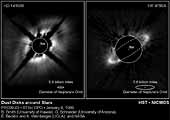|
COMETS EARTH JUPITER KUIPER BELT MARS MERCURY METEORITES NEPTUNE OORT CLOUD PLUTO SATURN SOLAR SYSTEM SPACE SUN URANUS VENUS ORDER PRINTS
PHOTO CATEGORIES SCIENCEVIEWS AMERICAN INDIAN AMPHIBIANS BIRDS BUGS FINE ART FOSSILS THE ISLANDS HISTORICAL PHOTOS MAMMALS OTHER PARKS PLANTS RELIGIOUS REPTILES SCIENCEVIEWS PRINTS
|
Related Documents
Download Options
[left]
The Hubble image, taken at a wavelength of 1.1 microns, was made using the coronagraph in the Near Infrared and Multi-Object Spectrometer (NICMOS) to reduce the glare of the star. The observed radiation from the disk is caused by dust particles which reflect the light of the central star. The dark spikes in the image are regions where there are no useful data due to diffraction artifacts introduced by the optical systems of the telescope and camera. The central portion of the disk remains unseen because of residual glare from the bright star. Credit: Alycia Weinberger, Eric Becklin (UCLA), Glenn Schneider (University of Arizona) and NASA
[right] The near-infrared light reflecting off the dust ring is about 1,000 times fainter than the illuminating central star. Astronomers used a coronagraphic camera on Hubble's Near Infrared Camera and Multi-Object Spectrometer (NICMOS), specifically designed to enable observations of very faint and low surface brightness objects in the close proximity to bright stars. Even with the coronagraph, the glare from HR 4796A overwhelms the much-fainter ring at distances less than about 4 billion miles (inside the blacked-out circle, centered on the star). Hubble's crisp view was able to resolve the ring, seen at lower resolution at longer wavelengths, in ground-based thermal infrared images, as a disk with some degree of central clearing. The ring has an angular radius of 1.05 arc seconds, equivalent to the apparent size of a dime seen more than 4 miles away. Unlike the extensive disks of dust seen around other young stars, the HR 4796A dust ring, 6.5 billion miles from the star, is tightly confined within a relatively narrow zone less than 17 Astronomical Units wide. An Astronomical Unit is the distance from the Earth to the Sun). For comparison, the ring width is approximately equal to the distance separating the orbits of Mars and Uranus in our own Solar System. All dust rings, whether around stars or planets, can only stay intact by some mechanism confining the dust, likely the gravitational tug of unseen planets. The image was taken on March 15, 1998, centered at a near infrared wavelength of 1.1 microns. The ring, which is undoubtedly circular, appears elliptical since it is inclined to our line-of-sight. Thus, the apparent spacing of the ring-particles, which act as reflectors of starlight, is greatest at the ansae of the projected ellipse giving rise to the brightening in these regions. Credit: Brad Smith (University of Hawaii), Glenn Schneider (University of Arizona), and NASA |
